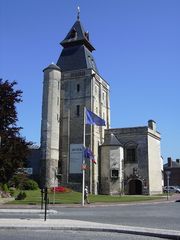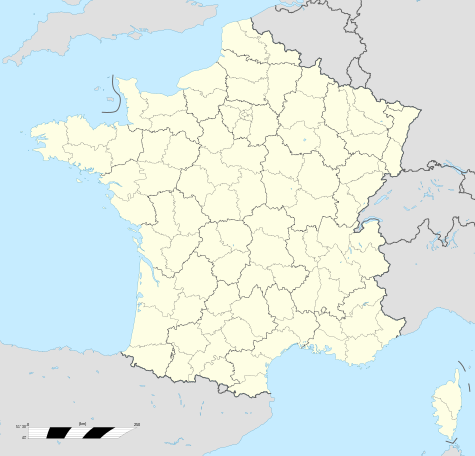Abbeville
|
Abbeville
|
| Abbeville église Rouvroy 2.jpg |
|
|
|
| Administration |
| Country |
France |
| Region |
Picardy |
| Department |
Somme |
| Arrondissement |
Abbeville |
| Canton |
Abbeville |
| Mayor |
Nicolas Dumont
(2008–2014) |
| Statistics |
| Elevation |
2–76 m (6.6–249 ft)
(avg. 8 m/26 ft) |
| Land area1 |
26.42 km2 (10.20 sq mi) |
| Population2 |
24,829 (2006) |
| - Density |
940 /km2 (2,400 /sq mi) |
| INSEE/Postal code |
80001/ 80100 |
| 1 French Land Register data, which excludes lakes, ponds, glaciers > 1 km² (0.386 sq mi or 247 acres) and river estuaries. |
| 2 Population sans doubles comptes: residents of multiple communes (e.g., students and military personnel) only counted once. |
Abbeville (Abbekerke in Dutch) is a commune in the Somme department in Picardie in northern France.
Location
Abbeville is located on the Somme River, 20 kilometres from its modern mouth in the English Channel, and 45 kilometres northwest of Amiens. In the medieval period, it was the lowest crossing point on the Somme and it was nearby that Edward III's army crossed shortly before the Battle of Crécy in 1346, but resist to the invaders..
Administration
Abbeville was the capital of the former province of Ponthieu. Today, it is one of the three sub-prefectures of the Somme department.

St. Vulfran Collegiate Church

Belfry
Prehistory
The name Abbeville has been adopted to name a category of early stone tools. These stone tools are also known as handaxes. Various handaxes were found near Abbeville by Jacques Boucher de Perthes during the 1830s and he was the first to describe the stones in detail, pointing out in the first publication of its kind, that the stones were chipped deliberately by early man, so as to form a tool. These earliest stone tools found in Europe were chipped on both sides so as to form a sharp edge, are now known as Abbevillian handaxes or bifaces.[1] The earlier form of stone tools, not found in Europe is known as Oldowan choppers. A more refined and later version of handaxe production was also found in the Abbeville/Somme River district. The more refined handaxe became known as the Acheulean industry, named after Saint-Acheul, today a suburb of Amiens.
History
Abbeville first appears in history during the ninth century. At that time belonging to the abbey of Saint-Riquier, it was afterwards governed by the Counts of Ponthieu. Together with that county, it came into the possession of the Alençon and other French families, and afterwards into that of the House of Castile, from whom by marriage it fell in 1272 to King Edward I of England. French and English were its masters by turns till 1435 when, by the treaty of Arras, it was ceded to the Duke of Burgundy. In 1477 it was annexed by King Louis XI of France, and was held by two illegitimate branches of the royal family in the 16th and 17th centuries, being in 1696 reunited to the crown. In 1514, the town saw the marriage of Louis XII of France to Mary Tudor, the daughter of Henry VII of England.
Abbeville was fairly important in the 18th century, when the Van Robais Royal Manufacture (one of the first major factories in France) brought great prosperity (but some class controversy) to the town. Voltaire, among others, wrote about it. He also wrote about a major incident of intolerance in which a young impoverished lord, the Chevalier de la Barre, was executed there for impiety (supposedly because he did not salute a procession for Corpus Christi, though the story is far more complex than that and revolves around a mutilated cross.)
Abbeville was the birthplace of Rear Admiral Amédée Courbet (1827–85), whose victories on land and at sea made him a national hero during the Sino-French War (August 1884 to April 1885). Courbet died in June 1885, shortly after the end of the war, at Makung in the Pescadores Islands, and his body was brought back to France and buried in Abbeville on 1 September 1885 after a state funeral at Les Invalides a few days earlier. Abbeville's old Haymarket Square (Place du Marché-au-Blé) was renamed Place de l'Amiral Courbet in July 1885, shortly after the news of Courbet's death reached France, and an extravagant baroque statue of Courbet was erected in the middle of the square at the end of the nineteenth century. The statue was damaged in a devastating German bombing raid during World War II.
On 12 September 1939 in Abbeville a conference took place in which France and the United Kingdom decided it was too late to send troops to help Poland in its fight against Germany as Poland by this time was already on the verge of defeat.
The Blitzkrieg

The German advance until 21 May 1940
In 1940, the Germans had massed the bulk of their armoured force in Panzer Group von Kleist, which attacked through the comparatively unguarded sector of the Ardennes and achieved a breakthrough at Sedan with air support. The group raced to the coast of the English Channel at Abbeville, thus isolating (21 May 1940) the British Expeditionary Force, Belgian Army, and some divisions of the French Army in northern France. (Citation of Wikipedia Blitzkrieg) The Battle of France was lost.
Charles de Gaulle (17–18 May 1940), as a Colonel in this period, launched a counterattack in the region of Laon (see the map) with 80 tanks to destroy the communication of the German armoured troops. His 4th DCR (armoured division) reached Montcornet. But, without support, the 4th DCR was forced to retreat. There was another counter-attack. After Laon (24 may) , de Gaulle was promoted to temporary general: On 28 May (...) the 4th DCR attacked twice to destroy a pocket captured by the enemy south of the Somme near Abbeville. The operation was successful, with over 400 prisoners taken and the entire pocket mopped up except for Abbeville (...) but in the second attack the 4th DCR failed to gain control of the city in the face of superior enemy numbers. [2]
Historical population
- 1901: 18,519
- 1906: 18,971
- 1990: 24,588
- 2006: 24,829
Sights
The city was very picturesque until the early days of the Second World War when it was bombed mostly to rubble in one night by the Germans. The town overall is now mostly modern and rebuilt. Several of the town's attractions remain, including:
- St. Vulfran's church, erected in the 15th, 16th and 17th centuries. The original design was not completed. The nave has only two bays and the choir is insignificant. The facade is a magnificent specimen of the flamboyant Gothic style, flanked by two Gothic towers.
- The Boucher de Perthes Museum, situated in the now unused bell tower is a tribute to Jacques Boucher de Crèvecœur de Perthes who also has a lycée named after him. The museum features art work and other artefacts from the 16th century onwards, and other exhibitions that change every few months.
- A monument aux morts with sculptural work by Louis-Henri Leclabart. A montage of photographs of this monument is shown below.

The Abbeville monument aux morts
Transport
Abbeville is served by trains on the line between Boulogne-sur-Mer and Amiens. Abbeville was the southern terminus of the Réseau des Bains de Mer, the line to Dompierre-sur-Authie opened on 19 June 1892 and closed on 10 March 1947.
International relations
Twin towns — Sister cities
Abbeville is twinned with:
See also
- Abbevillian
- Communes of the Somme department
References
Notes
External links
- Official website (in French)
- The monument aux morts of the Western Somme Article on monument aux morts
Communes of the Somme department  |
|
Abbeville · Ablaincourt-Pressoir · Acheux-en-Amiénois · Acheux-en-Vimeu · Agenville · Agenvillers · Aigneville · Ailly-le-Haut-Clocher · Ailly-sur-Noye · Ailly-sur-Somme · Airaines · Aizecourt-le-Bas · Aizecourt-le-Haut · Albert · Allaines · Allenay · Allery · Allonville · Amiens · Andainville · Andechy · Argœuves · Argoules · Arguel · Armancourt · Arquèves · Arrest · Arry · Arvillers · Assainvillers · Assevillers · Athies · Aubercourt · Aubigny · Aubvillers · Auchonvillers · Ault · Aumâtre · Aumont · Autheux · Authie · Authieule · Authuille · Avelesges · Aveluy · Avesnes-Chaussoy · Ayencourt · Bacouel-sur-Selle · Bailleul · Baizieux · Balâtre · Barleux · Barly · Bavelincourt · Bayencourt · Bayonvillers · Bazentin · Béalcourt · Beaucamps-le-Jeune · Beaucamps-le-Vieux · Beauchamps · Beaucourt-en-Santerre · Beaucourt-sur-l'Ancre · Beaucourt-sur-l'Hallue · Beaufort-en-Santerre · Beaumetz · Beaumont-Hamel · Beauquesne · Beauval · Bécordel-Bécourt · Becquigny · Béhen · Béhencourt · Bellancourt · Belleuse · Belloy-en-Santerre · Belloy-Saint-Léonard · Belloy-sur-Somme · Bergicourt · Bermesnil · Bernâtre · Bernaville · Bernay-en-Ponthieu · Bernes · Berneuil · Berny-en-Santerre · Bertangles · Berteaucourt-les-Dames · Berteaucourt-lès-Thennes · Bertrancourt · Béthencourt-sur-Mer · Béthencourt-sur-Somme · Bettembos · Bettencourt-Rivière · Bettencourt-Saint-Ouen · Beuvraignes · Biaches · Biarre · Biencourt · Billancourt · Blangy-sous-Poix · Blangy-Tronville · Boisbergues · Le Boisle · Boismont · Bonnay · Bonneville · Bosquel · Bouchavesnes-Bergen · Bouchoir · Bouchon · Boufflers · Bougainville · Bouillancourt-en-Séry · Bouillancourt-la-Bataille · Bouquemaison · Bourdon · Bourseville · Boussicourt · Bouttencourt · Bouvaincourt-sur-Bresle · Bouvincourt-en-Vermandois · Bouzincourt · Bovelles · Boves · Braches · Brailly-Cornehotte · Brassy · Bray-lès-Mareuil · Bray-sur-Somme · Breilly · Bresle · Breuil · Brévillers · Brie · Briquemesnil-Floxicourt · Brocourt · Brouchy · Brucamps · Brutelles · Buigny-l'Abbé · Buigny-lès-Gamaches · Buigny-Saint-Maclou · Buire-Courcelles · Buire-sur-l'Ancre · Bus-la-Mésière · Bus-lès-Artois · Bussu · Bussus-Bussuel · Bussy-lès-Daours · Bussy-lès-Poix · Buverchy · Cachy · Cagny · Cahon · Caix · Cambron · Camon · Camps-en-Amiénois · Canaples · Canchy · Candas · Cannessières · Cantigny · Caours · Cappy · Cardonnette · Le Cardonnois · Carnoy · Carrépuis · Cartigny · Caulières · Cavillon · Cayeux-en-Santerre · Cayeux-sur-Mer · Cerisy · Cerisy-Buleux · Champien · Chaulnes · La Chaussée-Tirancourt · Chaussoy-Epagny · La Chavatte · Chépy · Chilly · Chipilly · Chirmont · Chuignes · Chuignolles · Citerne · Cizancourt · Clairy-Saulchoix · Cléry-sur-Somme · Cocquerel · Coigneux · Coisy · Colincamps · Combles · Condé-Folie · Contalmaison · Contay · Conteville · Contoire · Contre · Conty · Corbie · Cottenchy · Coullemelle · Coulonvillers · Courcelette · Courcelles-au-Bois · Courcelles-sous-Moyencourt · Courcelles-sous-Thoix · Courtemanche · Cramont · Crécy-en-Ponthieu · Crémery · Cressy-Omencourt · Creuse · Croix-Moligneaux · Croixrault · Le Crotoy · Crouy-Saint-Pierre · Curchy · Curlu · Damery · Dancourt-Popincourt · Daours · Dargnies · Davenescourt · Démuin · Dernancourt · Devise · Doingt · Domart-en-Ponthieu · Domart-sur-la-Luce · Domesmont · Dominois · Domléger-Longvillers · Dommartin · Dompierre-Becquincourt · Dompierre-sur-Authie · Domqueur · Domvast · Doudelainville · Douilly · Doullens · Dreuil-lès-Amiens · Driencourt · Dromesnil · Drucat · Dury · Eaucourt-sur-Somme · L'Échelle-Saint-Aurin · Éclusier-Vaux · Embreville · Englebelmer · Ennemain · Épagne-Épagnette · Épaumesnil · Épécamps · Épehy · Épénancourt · Éplessier · Eppeville · Équancourt · Équennes-Éramecourt · Erches · Ercheu · Ercourt · Ergnies · Érondelle · Esclainvillers · Esmery-Hallon · Essertaux · Estrébœuf · Estrées-Deniécourt · Estrées-lès-Crécy · Estrées-Mons · Estrées-sur-Noye · Étalon · Ételfay · Éterpigny · Étinehem · L'Étoile · Étréjust · Étricourt-Manancourt · La Faloise · Falvy · Famechon · Faverolles · Favières · Fay · Ferrières · Fescamps · Feuillères · Feuquières-en-Vimeu · Fieffes-Montrelet · Fienvillers · Fignières · Fins · Flaucourt · Flers · Flers-sur-Noye · Flesselles · Fleury · Flixecourt · Fluy · Folies · Folleville · Fonches-Fonchette · Fontaine-le-Sec · Fontaine-lès-Cappy · Fontaine-sous-Montdidier · Fontaine-sur-Maye · Fontaine-sur-Somme · Forceville · Forceville-en-Vimeu · Forest-l'Abbaye · Forest-Montiers · Fort-Mahon-Plage · Fossemanant · Foucaucourt-en-Santerre · Foucaucourt-Hors-Nesle · Fouencamps · Fouilloy · Fouquescourt · Fourcigny · Fourdrinoy · Framerville-Rainecourt · Framicourt · Francières · Franleu · Franqueville · Fransart · Fransu · Fransures · Franvillers · Fréchencourt · Frémontiers · Fresnes-Mazancourt · Fresnes-Tilloloy · Fresneville · Fresnoy-Andainville · Fresnoy-au-Val · Fresnoy-en-Chaussée · Fresnoy-lès-Roye · Fressenneville · Frettecuisse · Frettemeule · Friaucourt · Fricamps · Fricourt · Frise · Friville-Escarbotin · Frohen-sur-Authie · Froyelles · Frucourt · Gamaches · Gapennes · Gauville · Gentelles · Gézaincourt · Ginchy · Glisy · Gorenflos · Gorges · Goyencourt · Grandcourt · Grand-Laviers · Gratibus · Grattepanche · Grébault-Mesnil · Grécourt · Grivesnes · Grivillers · Grouches-Luchuel · Gruny · Guerbigny · Gueschart · Gueudecourt · Guignemicourt · Guillaucourt · Guillemont · Guizancourt · Guyencourt-Saulcourt · Guyencourt-sur-Noye · Hailles · Hallencourt · Hallivillers · Halloy-lès-Pernois · Hallu · Ham · Le Hamel · Hamelet · Hancourt · Hangard · Hangest-en-Santerre · Hangest-sur-Somme · Harbonnières · Hardecourt-aux-Bois · Hargicourt · Harponville · Hattencourt · Hautvillers-Ouville · Havernas · Hébécourt · Hédauville · Heilly · Hem-Hardinval · Hem-Monacu · Hénencourt · Herbécourt · Hérissart · Herleville · Herly · Hervilly · Hesbécourt · Hescamps · Heucourt-Croquoison · Heudicourt · Heuzecourt · Hiermont · Hombleux · Hornoy-le-Bourg · Huchenneville · Humbercourt · Huppy · Hyencourt-le-Grand · Ignaucourt · Inval-Boiron · Irles · Jumel · Laboissière-en-Santerre · Lachapelle · Lafresguimont-Saint-Martin · Lahoussoye · Laleu · Lamaronde · Lamotte-Brebière · Lamotte-Buleux · Lamotte-Warfusée · Lanchères · Lanches-Saint-Hilaire · Languevoisin-Quiquery · Laucourt · Laviéville · Lawarde-Mauger-l'Hortoy · Léalvillers · Lesbœufs · Liancourt-Fosse · Licourt · Liéramont · Liercourt · Ligescourt · Lignières · Lignières-Châtelain · Lignières-en-Vimeu · Lihons · Limeux · Liomer · Loeuilly · Long · Longavesnes · Longpré-les-Corps-Saints · Longueau · Longueval · Longuevillette · Louvencourt · Louvrechy · Lucheux · Machiel · Machy · Mailly-Maillet · Mailly-Raineval · Maisnières · Maison-Ponthieu · Maison-Roland · Maizicourt · Malpart · Mametz · Marcelcave · Marché-Allouarde · Marchélepot · Marestmontiers · Mareuil-Caubert · Maricourt · Marieux · Marlers · Marquaix · Marquivillers · Martainneville · Matigny · Maucourt · Maurepas · Le Mazis · Méaulte · Méharicourt · Meigneux · Le Meillard · Méneslies · Méréaucourt · Mérélessart · Méricourt-en-Vimeu · Méricourt-l'Abbé · Méricourt-sur-Somme · Mers-les-Bains · Le Mesge · Mesnil-Bruntel · Mesnil-Domqueur · Mesnil-en-Arrouaise · Mesnil-Martinsart · Mesnil-Saint-Georges · Mesnil-Saint-Nicaise · Métigny · Mézerolles · Mézières-en-Santerre · Miannay · Millencourt · Millencourt-en-Ponthieu · Miraumont · Mirvaux · Misery · Moislains · Molliens-au-Bois · Molliens-Dreuil · Monchy-Lagache · Mons-Boubert · Monsures · Montagne-Fayel · Montauban-de-Picardie · Montdidier · Montigny-les-Jongleurs · Montigny-sur-l'Hallue · Montonvillers · Morchain · Morcourt · Moreuil · Morisel · Morlancourt · Morvillers-Saint-Saturnin · Mouflers · Mouflières · Moyencourt · Moyencourt-lès-Poix · Moyenneville · Muille-Villette · Nampont · Namps-Maisnil · Nampty · Naours · Nesle · Nesle-l'Hôpital · Neslette · Neufmoulin · Neuilly-le-Dien · Neuilly-l'Hôpital · Neuville-au-Bois · Neuville-Coppegueule · La Neuville-lès-Bray · Neuville-lès-Loeuilly · La Neuville-Sire-Bernard · Neuvillette · Nibas · Nouvion · Noyelles-en-Chaussée · Noyelles-sur-Mer · Nurlu · Occoches · Ochancourt · Offignies · Offoy · Oisemont · Oissy · Omiécourt · Oneux · Oresmaux · Oust-Marest · Outrebois · Ovillers-la-Boisselle · Pargny · Parvillers-le-Quesnoy · Pendé · Pernois · Péronne · Pertain · Picquigny · Piennes-Onvillers · Pierregot · Pierrepont-sur-Avre · Pissy · Plachy-Buyon · Le Plessier-Rozainvillers · Poeuilly · Poix-de-Picardie · Ponches-Estruval · Pont-de-Metz · Ponthoile · Pont-Noyelles · Pont-Remy · Port-le-Grand · Potte · Poulainville · Pozières · Prouville · Prouzel · Proyart · Puchevillers · Punchy · Puzeaux · Pys · Quend · Querrieu · Le Quesne · Le Quesnel · Quesnoy-le-Montant · Quesnoy-sur-Airaines · Quevauvillers · Quiry-le-Sec · Quivières · Raincheval · Rainneville · Ramburelles · Rambures · Rancourt · Regnière-Écluse · Remaisnil · Remaugies · Remiencourt · Rethonvillers · Revelles · Ribeaucourt · Ribemont-sur-Ancre · Riencourt · Rivery · Rogy · Roiglise · Roisel · Rollot · Ronssoy · Rosières-en-Santerre · Rouvrel · Rouvroy-en-Santerre · Rouy-le-Grand · Rouy-le-Petit · Roye · Rubempré · Rubescourt · Rue · Rumigny · Saigneville · Sailly-Flibeaucourt · Sailly-Laurette · Sailly-le-Sec · Sailly-Saillisel · Sains-en-Amiénois · Saint-Acheul · Saint-Aubin-Montenoy · Saint-Aubin-Rivière · Saint-Blimont · Saint-Christ-Briost · Sainte-Segrée · Saint-Fuscien · Saint-Germain-sur-Bresle · Saint-Gratien · Saint-Léger-lès-Authie · Saint-Léger-lès-Domart · Saint-Léger-sur-Bresle · Saint-Mard · Saint-Maulvis · Saint-Maxent · Saint-Ouen · Saint-Quentin-en-Tourmont · Saint-Quentin-la-Motte-Croix-au-Bailly · Saint-Riquier · Saint-Sauflieu · Saint-Sauveur · Saint-Vaast-en-Chaussée · Saint-Valery-sur-Somme · Saisseval · Saleux · Salouël · Sancourt · Saulchoy-sous-Poix · Sauvillers-Mongival · Saveuse · Senarpont · Senlis-le-Sec · Sentelie · Seux · Sorel · Sorel-en-Vimeu · Soues · Sourdon · Soyécourt · Surcamps · Suzanne · Tailly · Talmas · Templeux-la-Fosse · Templeux-le-Guérard · Terramesnil · Tertry · Thennes · Thézy-Glimont · Thiepval · Thieulloy-l'Abbaye · Thieulloy-la-Ville · Thièvres · Thoix · Thory · Tilloloy · Tilloy-Floriville · Tilloy-lès-Conty · Tincourt-Boucly · Le Titre · Tœufles · Tours-en-Vimeu · Toutencourt · Le Translay · Treux · Tully · Ugny-l'Équipée · Vadencourt · Vaire-sous-Corbie · Valines · Varennes · Vauchelles-lès-Authie · Vauchelles-lès-Domart · Vauchelles-les-Quesnoy · Vaudricourt · Vauvillers · Vaux-en-Amiénois · Vaux-Marquenneville · Vaux-sur-Somme · Vecquemont · Velennes · Vercourt · Vergies · Vermandovillers · Verpillières · Vers-sur-Selles · La Vicogne · Vignacourt · Villecourt · Ville-le-Marclet · Villeroy · Villers-aux-Érables · Villers-Bocage · Villers-Bretonneux · Villers-Campsart · Villers-Carbonnel · Villers-Faucon · Villers-lès-Roye · Villers-sous-Ailly · Villers-sur-Authie · Villers-Tournelle · Ville-sur-Ancre · Vironchaux · Vismes · Vitz-sur-Authie · Voyennes · Vraignes-en-Vermandois · Vraignes-lès-Hornoy · Vrély · Vron · Wargnies · Warloy-Baillon · Warlus · Warsy · Warvillers · Wiencourt-l'Équipée · Wiry-au-Mont · Woignarue · Woincourt · Woirel · Y · Yaucourt-Bussus · Yonval · Yvrench · Yvrencheux · Yzengremer · Yzeux
|
|





 This article incorporates text from a publication now in the public domain: Chisholm, Hugh, ed (1911). Encyclopædia Britannica (Eleventh ed.). Cambridge University Press.
This article incorporates text from a publication now in the public domain: Chisholm, Hugh, ed (1911). Encyclopædia Britannica (Eleventh ed.). Cambridge University Press.